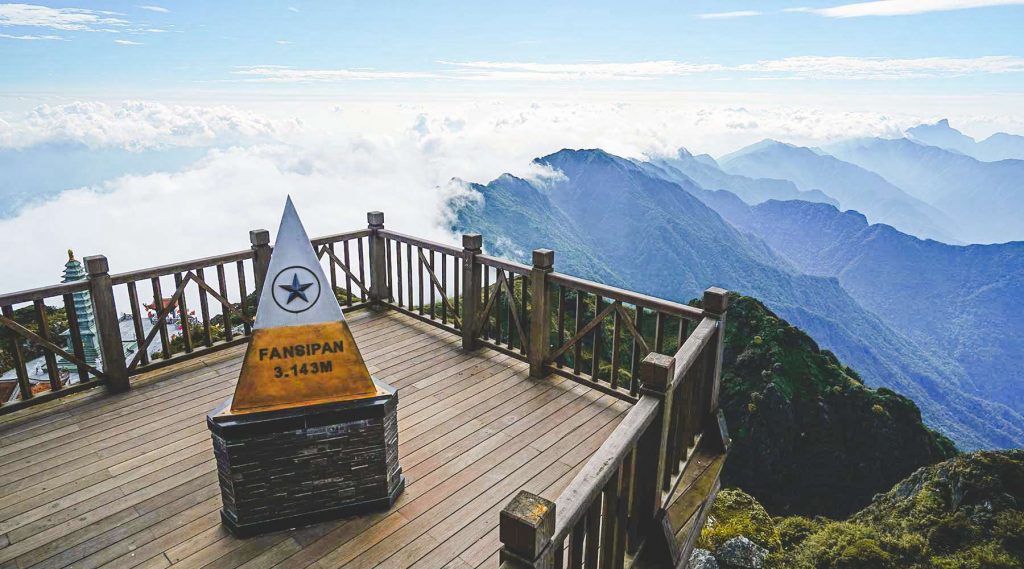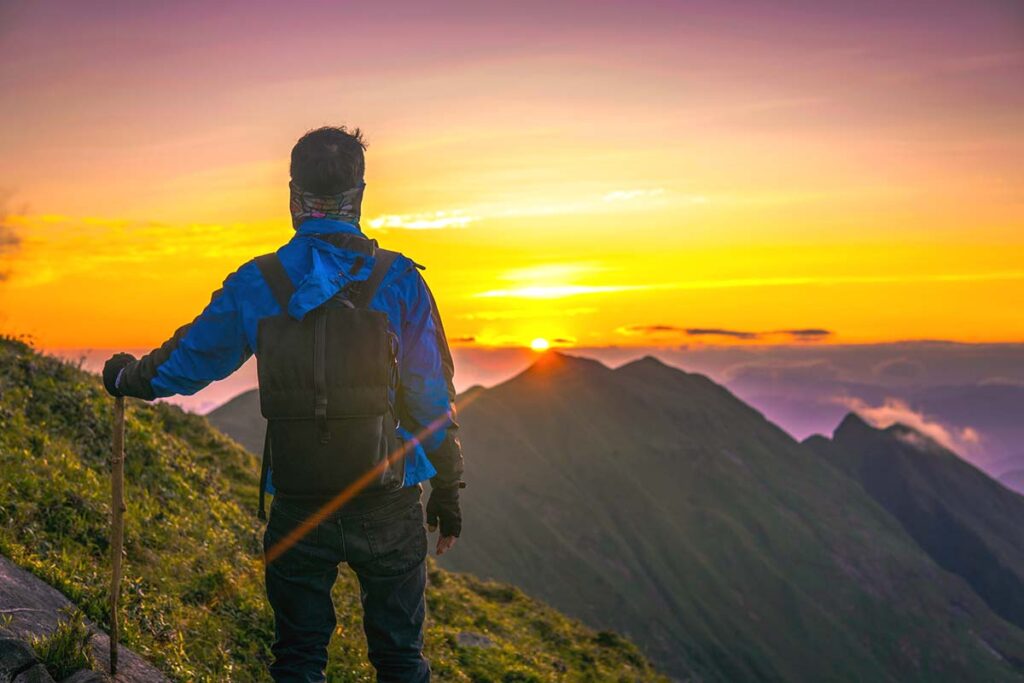About Fansipan Mountain
Fansipan, often referred to as the “Roof of Indochina,” is the highest mountain in Vietnam and the entire Indochina peninsula, reaching an elevation of 3,143 meters. It’s part of the rugged Hoang Lien Son mountain range in northern Vietnam, just a short distance from Sapa. For many years, only adventurous trekkers could reach its summit, but since 2016, a modern cable car has made it accessible to nearly everyone—without the need for hiking gear or mountain stamina.
Fansipan climbing or cable car
Fansipan was the best of the mountains in Vietnam you could climb. You could only reach the top on foot. Since February 2016 there is a cable car. Instead of walking one to three days to the top, you are there with the cable car in just 15-20 minutes. If you like it and you like a challenge, you can still choose to climb the mountain. You can do it within 1 day, 2 days or 3 days. During a multi-day trip you will stay in a cabin or tent on the mountain. Keep in mind that the top of the mountain is often in the clouds and that you therefore have little view, so do it mainly for the experience.
Are you coming to Sapa for the beautiful views over rice fields and do you want to see something of the local ethnic cultures? Then you better not climb Fansipan, but make a trekking in Sapa through the Muong Hoa valley.
If you would like to stand on the highest mountain in Vietnam, but do not want to make a tiring climb, then choose the Fansipan cable car.
Continue reading here for everything you need to know about climbing Fansipan.
8 Highlights of Fansipan
1. Mountain train
The first highlight of Fansipan is the funicular train going from Sapa town to the cable car station. It is also called the Muong Hoa mountain train, as on the way you can enjoy views of the famous Sapa rice fields in the Muong Hoa valley. The train starts in the city, close to the MGallery hotel. The train passes a few tnnels and crosses a impressive viaduct with some of the best views during the ride.
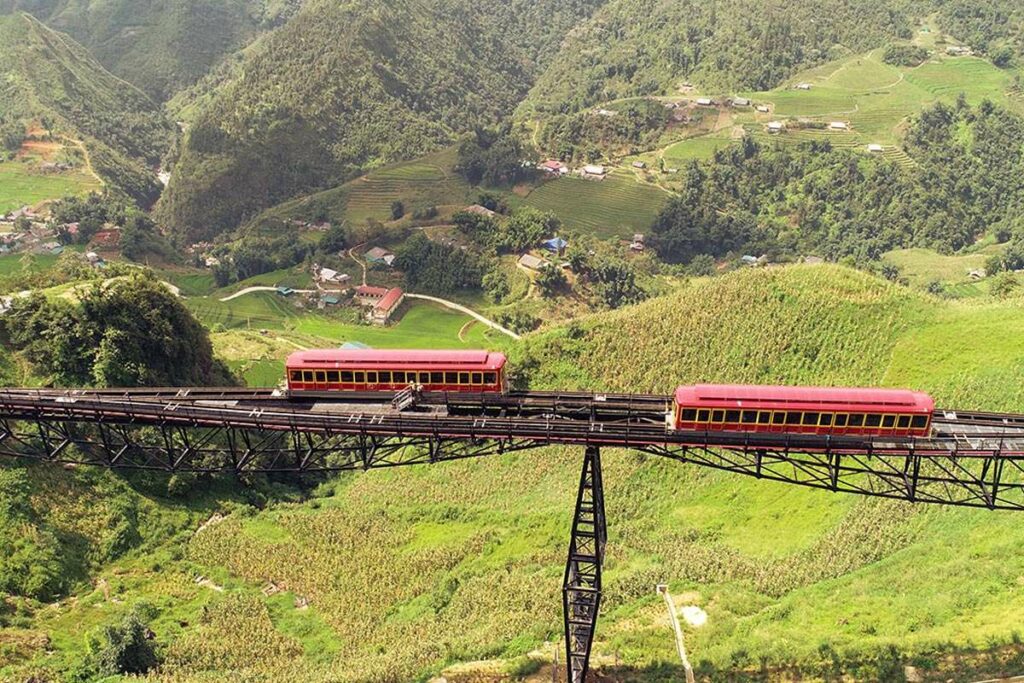
2. Fansipan cable car
If you don’t like walking or your budget or body can’t handle it, there is always the cable car option. This Fansipan Legend cable car is also an adventure because it spans 6,292.5 meters, making it the longest three-cable and non-stop cable car in the world. Not only that, it also has the record for highest gain with 1,410 meters for a three-cable cable car. It floats through clouds with views over the Muong Hoa Valley and through the beautiful peaks of the Hoang Lien Son Range.
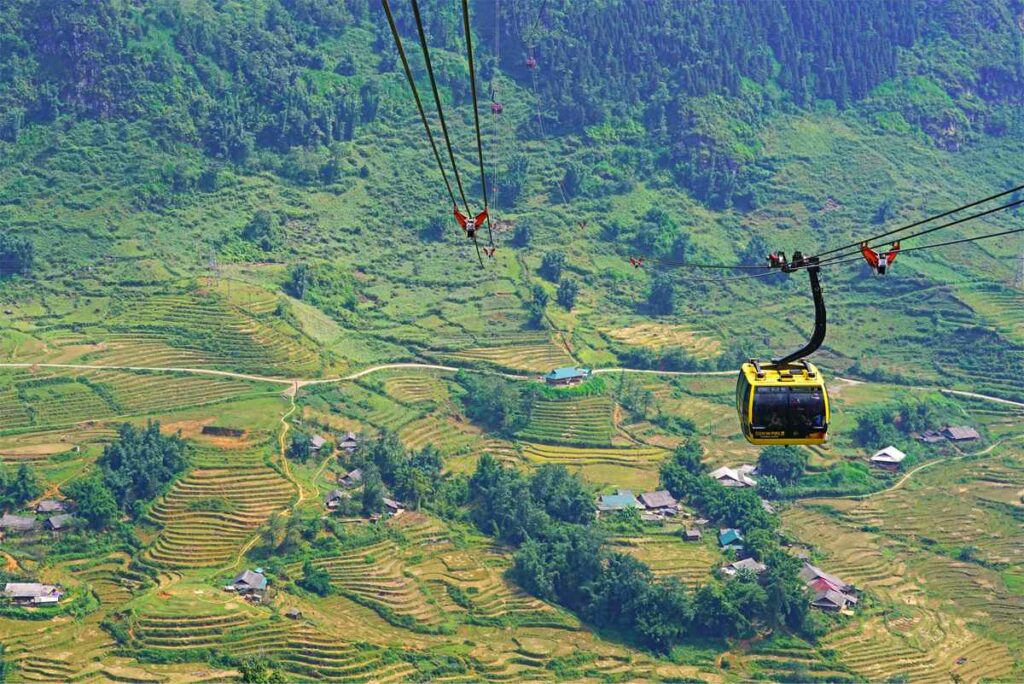
Cable car ticket price and opening times
The cable car opening times are daily from 7:30 AM to 5:30 PM.
For this reason it will be difficult to see sunrise or sunset on the top of Fansipan. However, make sure you are here around noon when it is less foggy.
You can buy the tickets online at the website of Fansipan Sunword or directly at the station, the price of tickets is stated publicly. The price is 700,000 VND for adults and for children this is VND 400,000. Children under 1m height can go for free.
3. Peak of Fansipan
From the station on Fansipan to the top you have to climb 600 steps. The views on top are without doubt the biggest highlights of Fansipan.
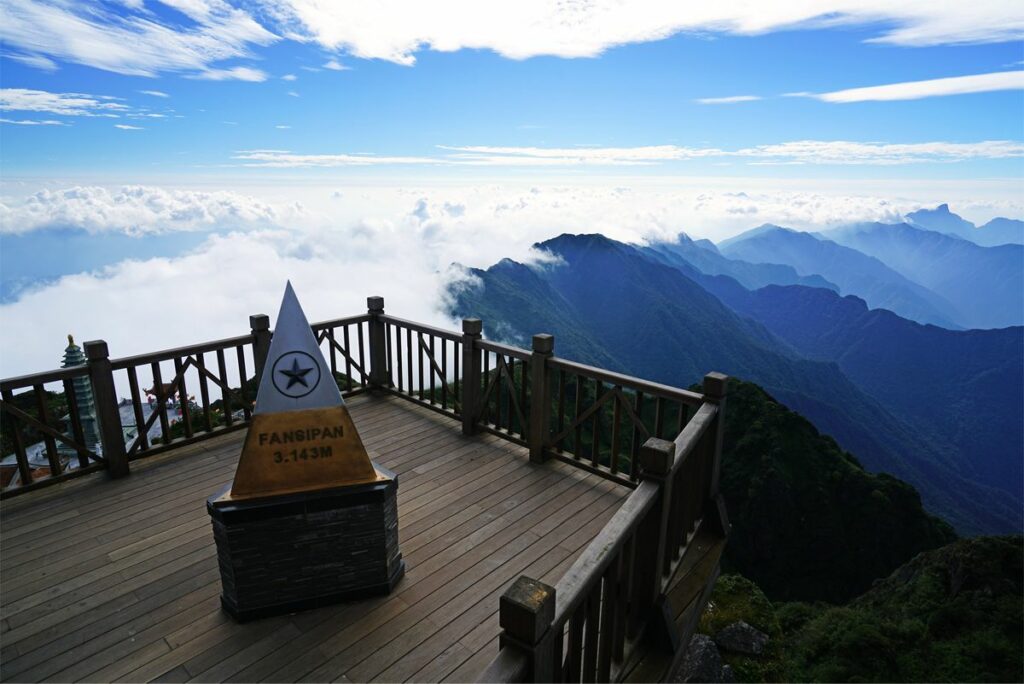
4. Funicular train to the peak
For those in good health or in good weather, climbing the steps to the peak would not be a problem. But for the elderly or when visiting on a windy day, you can choose the Do Quyen mountain train to reach Fansipan. Depending on the situation, you can purchase a single or return ticket. The train starts directly next to the cable car station and offers great views of the mountains below and to some of the temples and statues part of Fansipan Sunword.
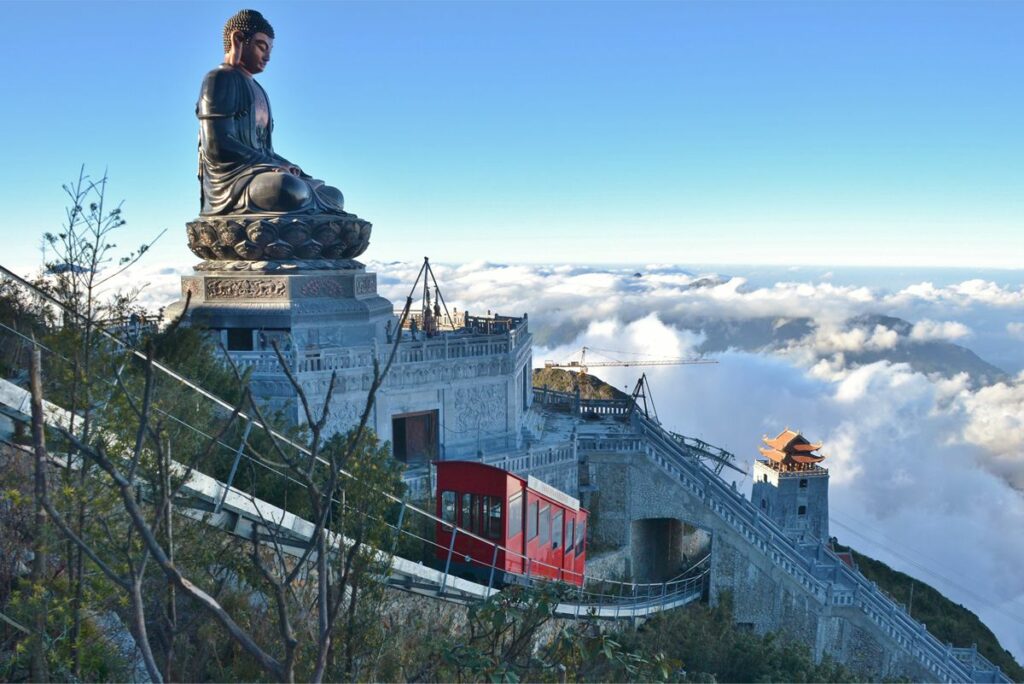
5. Temples and gardens on Fansipan
On Fansipan you have different temples that you can visit. When you do this, make sure you wear discreet and polite clothing. There are 11 spiritual attractions. You will also find a number of gardens. The most impressive sights are The Guanyin Statue, The Bao An Zen Monastery, The Great Buddha Statue, The Grand Belfry and the Stupa. All of these sights are part of the SunWorld Fansipan Legend park and not old. They don’t give a very authentic feeling to the landscape but they do offer some great views.
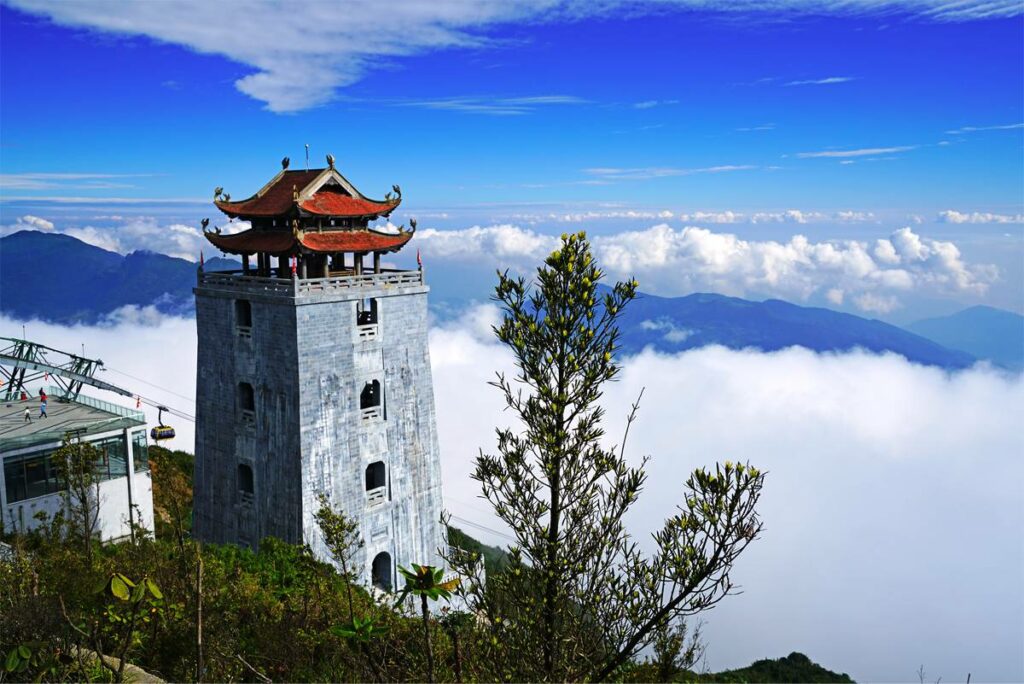
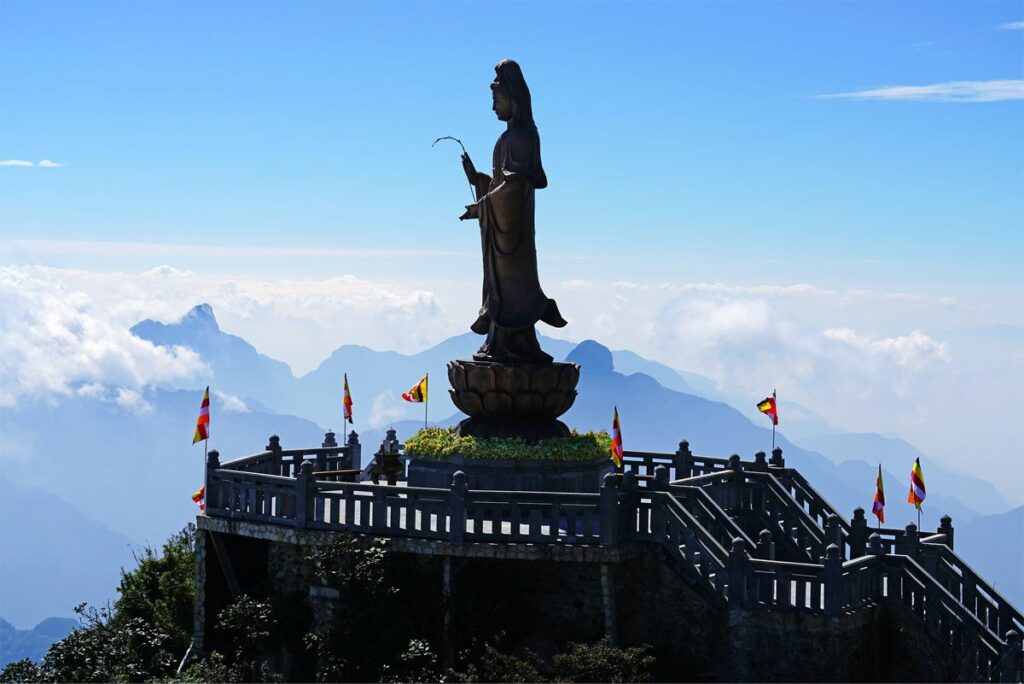
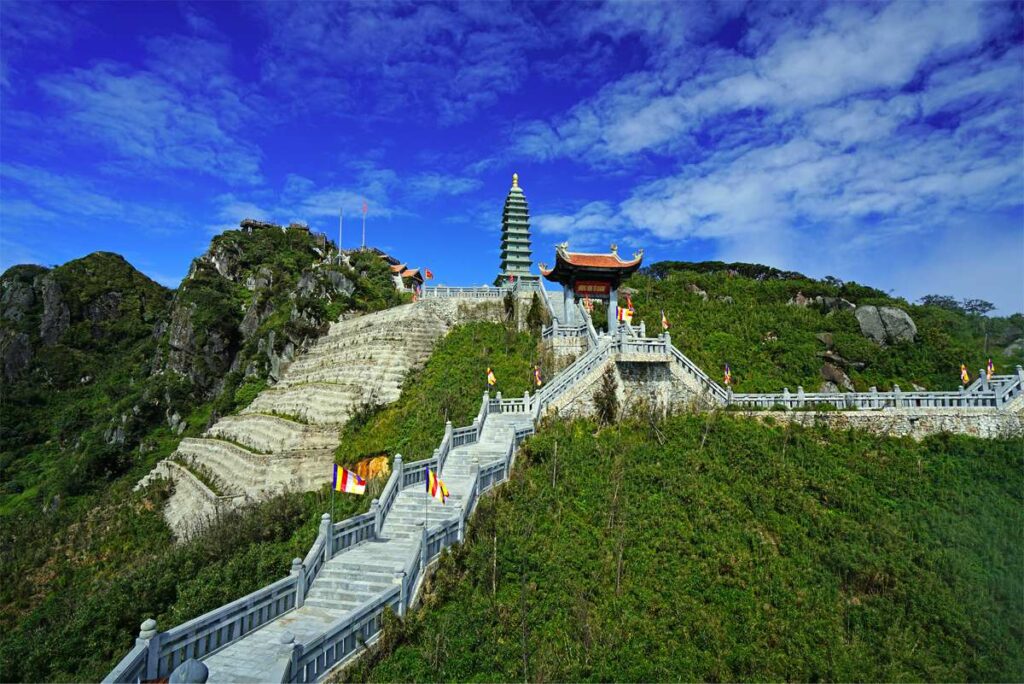
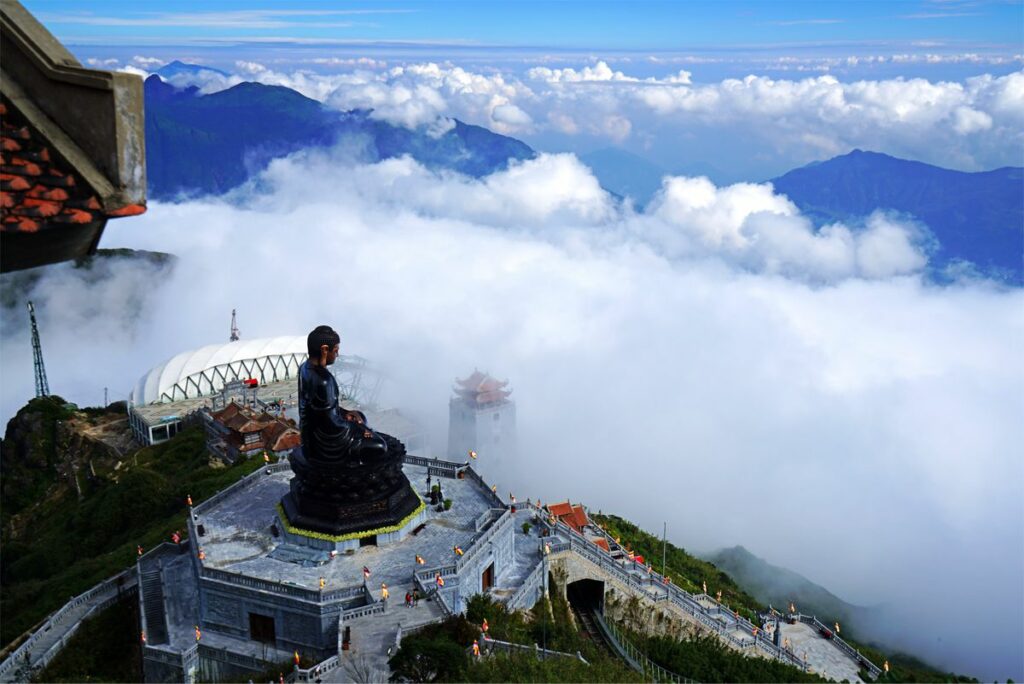
6. Tallest flagstaff of Indochina
This flagstaff at Fansipan is not as impressive as the Lung Cu flag tower in Ha Giang, but it is according to SunWorld the tallest flagstaff of Indochina. It is 25 meter tall and the base of the flagpole is dotted with refined bas-reliefs that recreate the essences of Vietnamese culture, including the Cham Towers, Central Highlands stilt houses, Northwestern cultures or the New World Wonder of Halong Bay.
7. Useful facilities
Maybe less of an actual highlight, but there are a few restaurants to be found on the same level as the top cable car station. They are a little bit more expanse compared with the restaurants in the city, but it is nice to enjoy a lunch here before you go down. In additional there are also a few cafes to get a hot drink on cold days or to relax for a bit after walking the stairs to a few temples around. They also even added four different shops to buy snacks and souvenirs.
8. Tram Ton Pass and waterfalls
On the other side of Fansipan than where Sapa is located you will find the Tram Ton pass. This is the highest mountain pass in Vietnam, with impressive views. It is about 17 km from the city and can be reached by taxi (or car with driver) or you can rent a motorbike in Sapa from 100,000 VND per day. In addition to visiting the mountain pass, you will also find two waterfalls here. The Silver waterfall is right next to the road and for the Love waterfall you have to hike for half an hour through a beautiful forest area. Near this last mentioned waterfall you will also find the start of the path to climb Fansipan.
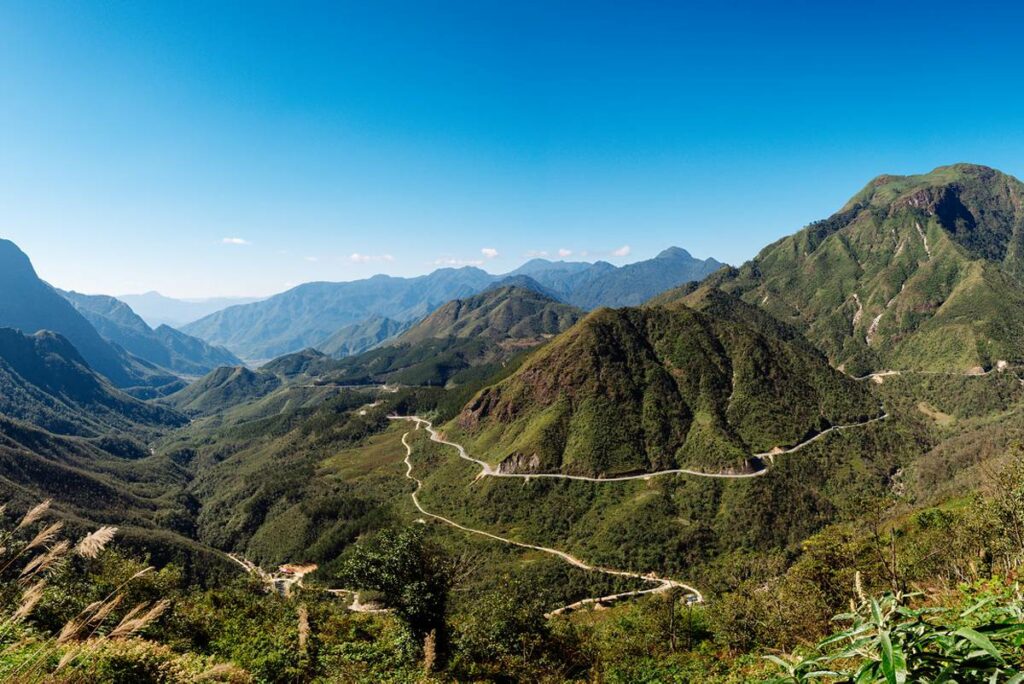
How do you get to the Fansipan?
Fansipan is located right next to the mountain town of Sapa in North Vietnam. To reach Fansipan, you first need to travel to Sapa itself. Most travelers come from Hanoi, either by tourist sleeper train via Lao Cai or by bus and limousine van over the express highway directly to Sapa. You can read all the details in our separate guide: How to get from Hanoi to Sapa.
Once you’re in Sapa town, there are a few ways to reach the Fansipan cable car station, located at the Sun World Fansipan Legend complex, about 3 kilometers from the town center.
Mountain train (Muong Hoa Train) – The most scenic way
The Muong Hoa mountain train connects the center of Sapa directly to the Fansipan cable car station. The station in town is located right next to the Hotel de la Coupole (MGallery) and appears on Google Maps as Sun World Sapa Ticket Station.
The train ride itself is short—just under 2 km—but passes through tunnels, over viaducts, and offers beautiful views of the Muong Hoa Valley. If your hotel is near the station, you can easily walk there. Otherwise, taxis and electric carts (buggy taxis) are available to take you to the station.
Taxi or electric buggy – Fast and easy
A regular taxi ride from the center of Sapa to the Fansipan cable car station takes about 10 minutes and costs around 40,000 VND. You can also choose an open electric buggy, which operates like a taxi and is widely available in town. This is a convenient option, especially if you prefer not to walk or are staying further from the train station.
Walking – A scenic option
Walking to the cable car station is possible but depends on where you stay. From the edge of Sapa town, it’s about 2 km, but from the center or further accommodations, the distance can be up to 3–4 km. The walk is manageable for most and takes you through town and small part with views over rice fields. Just follow the signs from the stone church in the town center toward Nguyen Chi Thanh Street, which leads straight to the cable car station.
Best time to visit Fansipan
Unlike Sapa’s rice fields—which are only at their most beautiful during specific months—Fansipan is a destination you can visit year-round. What really matters is catching a clear day for the best views. Some seasons offer better chances for clear skies, but in the end, weather in the mountains is always unpredictable.
Spring and Autumn – Generally the best balance
March to May and September to October are often considered the best times to visit Fansipan. These months have the most stable weather—less rain, pleasant temperatures, and a good chance of clear skies. Just keep in mind that late autumn (October) and early spring (March) can be chilly on the summit.
Summer – Surprisingly good for views (with rain)
Many assume summer isn’t ideal because of the rainy season (June to August), but in reality, it often offers clearer skies than expected. Rain tends to come in short, heavy bursts, often in the late afternoon or evening. The rest of the day can be bright and clear—a lot more so than in winter. Plus, the temperatures are more comfortable at the summit compared to colder months.
Winter – Cold, foggy, but with a chance of snow
December to February is the coldest period. This season often brings heavy fog, meaning visibility can be very limited—sometimes no views at all. However, winter also offers the unique possibility of seeing snow or frost on Fansipan. While snow in Sapa town is rare and doesn’t happen every year, the summit of Fansipan sees white frost every winter and occasional snowfall.
Read here more about the best time to visit Sapa.
A complete guide to climbing Fansipan
Fansipan attracted at least 100 climbers daily before the cable car. The climbing industry was hit and saw a 70% decrease in the number of climbers. Not all of these climbers opted for the cable car, some avoided Fansipan altogether because they believed that the cable car turned the top into a tourist trap.
Regardless of the new cable car that takes people to the top of this big peak, it is still quite an experience to make it anyway, to meet travelers, experience adventure and talk to the locals.
Fansipan Mountain Climbing Tour in 2 Days
- Experience: Trekking to Vietnam’s highest peak with an overnight stay in a mountain camp.
- Includes: All transfers from Hanoi, local guide, meals, and full trekking support.
Best period
For the most ideal circumstances, make the climb between October and April. During the summer it can rain and make the path insidious, even with good walking shoes. However, December and January can be quite cold, it can even snow on the peak!
Different options and levels
There are different options, depending on your desired level of adventure, endurance and time frame. The tours vary from 1 to 4 days.
There are 3 different routes that go to the top, all with separate levels of difficulty and length:
- Tram Ton: This path is the most popular by climbers, because the path is the most gradually . The distance between the starting point, at around 1500 meters, and the peak is 11 kilometers. This trail can be either completed in a day, but usually within 2 days.
- Sin Chai: This path is shorter but it is mainly for experience hikers. It is insidious and walkers often report that they can no longer find the way. The distance from start to finish is approximately 9 kilometers You may need 2 or 3 days to do this route.
- Cat Cat: The longest route start from this village, but it has the best scenic views along the way. The distance from the start to the top is approximately 20 kilometers. This track usually takes about 3 to 4 days to complete.
You can etiher do a private trekking or group with a group. With a group it can be a lot more fun, have conversations in the evening at campfire and social time during the trek. With a private tour is is easier to set your own speed and plan.
Climb Fansipan with or without a guide
Officially you cannot go without a guide. There are still people who do this, but we do not recommend this. In the past, people lost their way and there were even fatal accidents. Always bring a guide! Guides also arrange the permits and register the walk with the local authorities.
Before you see your guide carefully review the reviews and prices. An alternative is to choose a guide from the many local people upon arrival in Sapa. In this way you give money directly to families who work hard in this area. If you see this as a risk, it is better to book a trek with a travel agency.
The route
Most people who book guides, regardless of which path is indicated, take the Tram Ton route. You will be picked up early for your departure, probably around 7:00 or 8:00, because most guides assume that it takes all day to reach the campsite. But even if you are a bit fit, it will take much less time, but that also depends on the number of photos you want to take. Stay awake for the ride over the Tram Ton pass, the highest mountain pass in Vietnam.
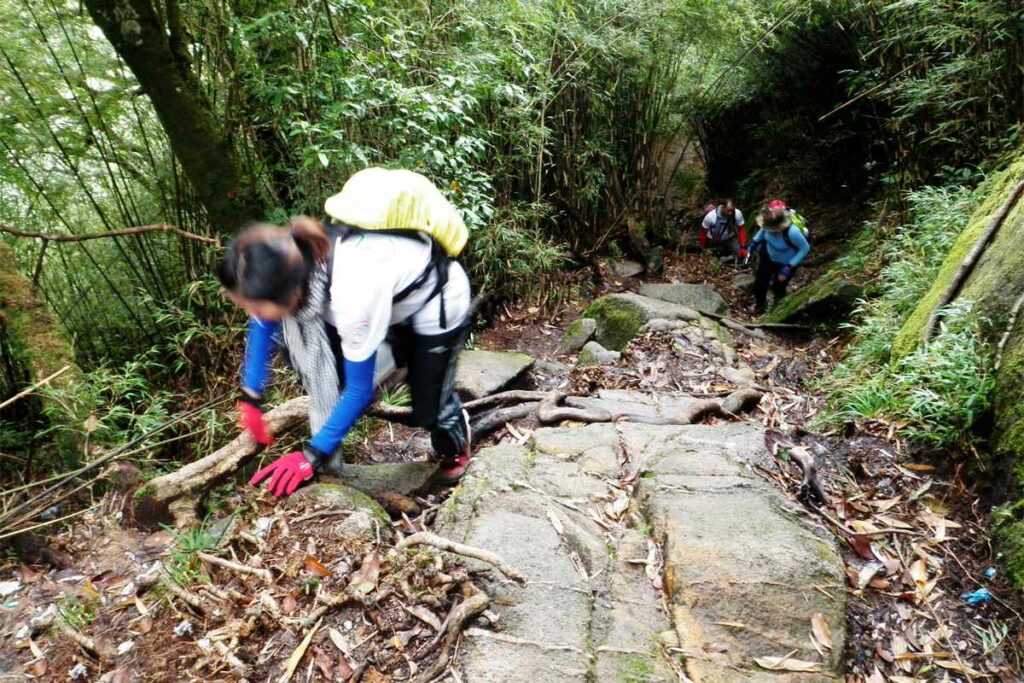
You will probably be accompanied by local porters and chefs who take part of the stuff with them. Much of the path has been cleared for tourists. Sometimes there are paved steps, ladders and a very clear path. You stop for lunch prepared by the porters.
Basecamp is located at 2800 meters, so if you suffer from altitude sickness, make sure you drink a lot of water when you arrive. Keep in mind that there is no electricity, the toilets are squat toilets and if you do this trip in the winter, the water will be very cold.
It is highly advisable to wake up early (around 4:00 a.m.) to watch the sunrise at the top and to be ahead of all cable car tourists. This will be a great experience as the sun rises over the mountains.
Tip! Want to climb Fansipan? Check our unique Fansipan climbing tour, starting from Hanoi.
Frequently asked questions about Fansipan
Is Fansipan cable car worth it?
The views on top of the the mountain are impressive on clear days, but keep in mind that there are often clouds hanging that can block your view. The temples and pagodas on top of the mountains are not old and part of the Fanispan Legend attraction. If you just have a few days in Sapa and looking for a more authentic experience it is best to visit the minority villages in the valley and enjoy breathtaking views on the rice fields.
Where is Fansipan mountain?
Fansipan mountain is located in Lao Cai Province, close to Sapa in Vietnam.
How much is Fansipan cable car?
The price is 700,000 VND for adults and for children this is VND 400,000. Children under 1m height can go for free.
What is Fansipan Legend?
Sun World is a big entertainment brand of the Sun Group, that owns also Asia Park and Ba Na Hills near Da Nang and several other attraction parks. Fansipan Legend is one of their attractions, including the cable car, mountain train and several temples on top of the mountain.
What does Fansipan mean?
The name Fansipan does not mean anything in Vietnamese. Theory is that the name came from Hủa Xi Pan, which means the tottering giant rock in the language of Hmong minority that lives around Sapa.
